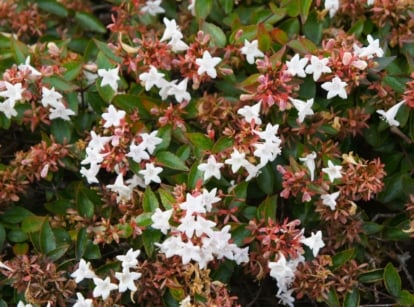How to Plant, Grow, and Care for Winter Honeysuckle
Honeysuckles are fragrant shrubs or vines perfect for chilly climates. Winter honeysuckle is a special type from China that grows well in North America. Give it plenty of space, airflow, and light, and it’ll fill your backyard with alluring, aromatic blossoms for decades.
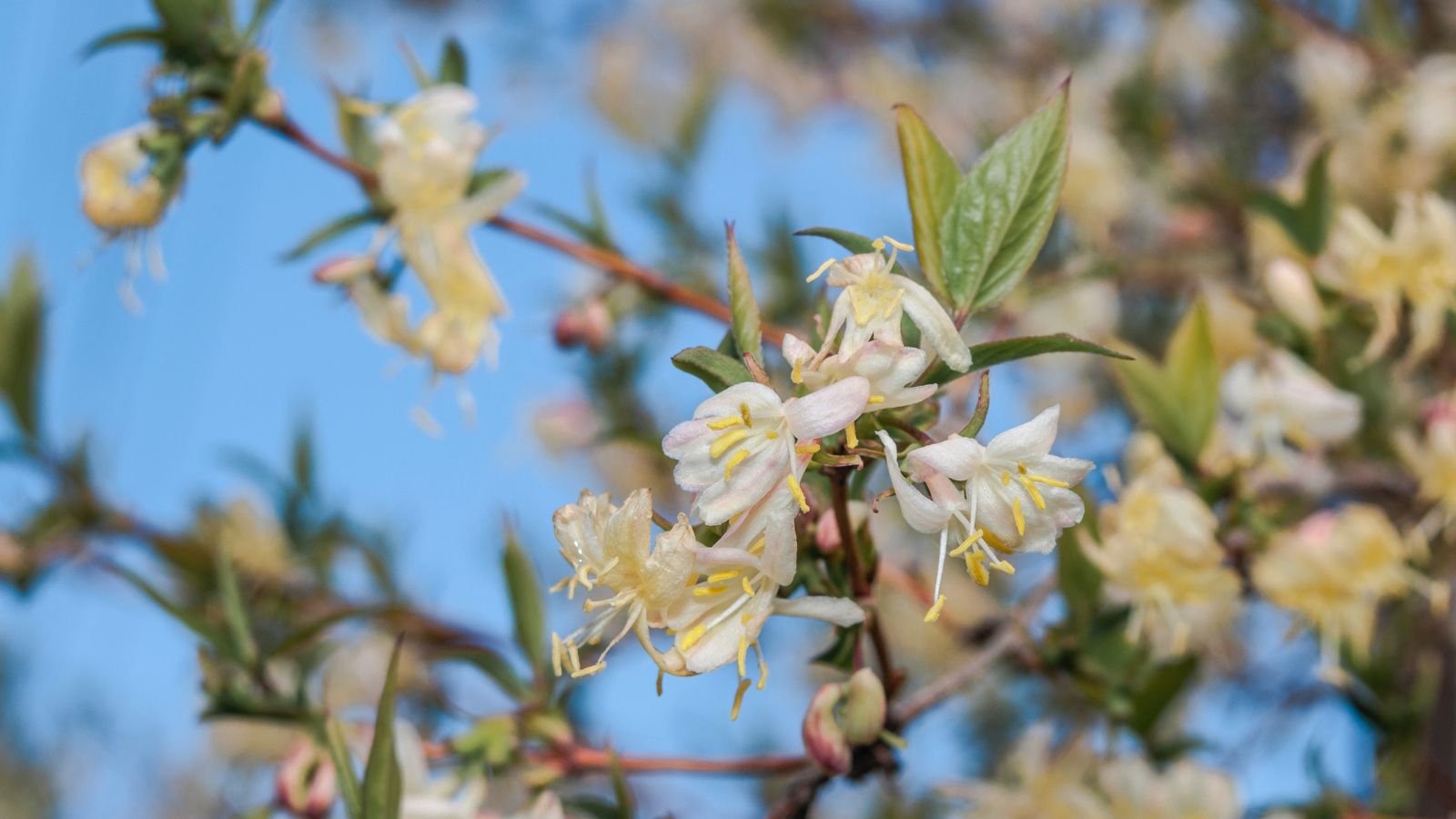
Contents
Fragrant flowers are one of nature’s many gifts! They fill the air with lovely aromas that tantalize us living creatures. We, alongside pollinators like bees, butterflies, and bats, move to smelly flowers like moths drawn to a flame. We crave their fragrance so much that we isolate it and put it in perfumes for daily enjoyment!
Out of all the fragrances of the natural world, honeysuckle is one that many treasure. Typically, honeysuckle plants grow like vines along the ground or as shrubs with erect branches. Winter honeysuckle defies categorization, as it displays traits of both. It’s a shrub with long, clambering branches that may touch the ground.
Winter honeysuckle, although gorgeous and fragrant, is a problem shrub in some regions of North America. Avoid growing it in the Midwest, as it can quickly displace native plants in forested areas. It’s on invasive species lists in Illinois, Pennsylvania, New Jersey, Virginia, West Virginia, South Carolina, and Georgia.
This honeysuckle grows well from USDA hardiness zones 4 through 8. It’s exceptionally cold-hardy and incredibly good-smelling. Try sniffing one before you buy, and I guarantee you’ll fall in love with the smell!
Winter Honeysuckle Overview

|
Plant Type
Deciduous to semi-evergreen shrub
Family
Caprifoliaceae
Genus
Lonicera
Species
fragrantissima
|
Native Area
Eastern and Southern China
Exposure
Full sun to partial shade
Height
6-10’
Watering Requirements
Low
|
Pests & Diseases
Aphids, scales, sawflies, white flies, loopers, plant hoppers, flea beetles, webworms, blight, leaf spots, mildew
Maintenance
High
Soil Type
Well-drained
Hardiness Zone
4-8
|
What Is It?
Honeysuckles are a part of the genus Lonicera. They’re native to many parts of the world, like Asia, the Americas, and Europe. Winter honeysuckle is one of dozens of fragrant species that exist worldwide.
Native Area
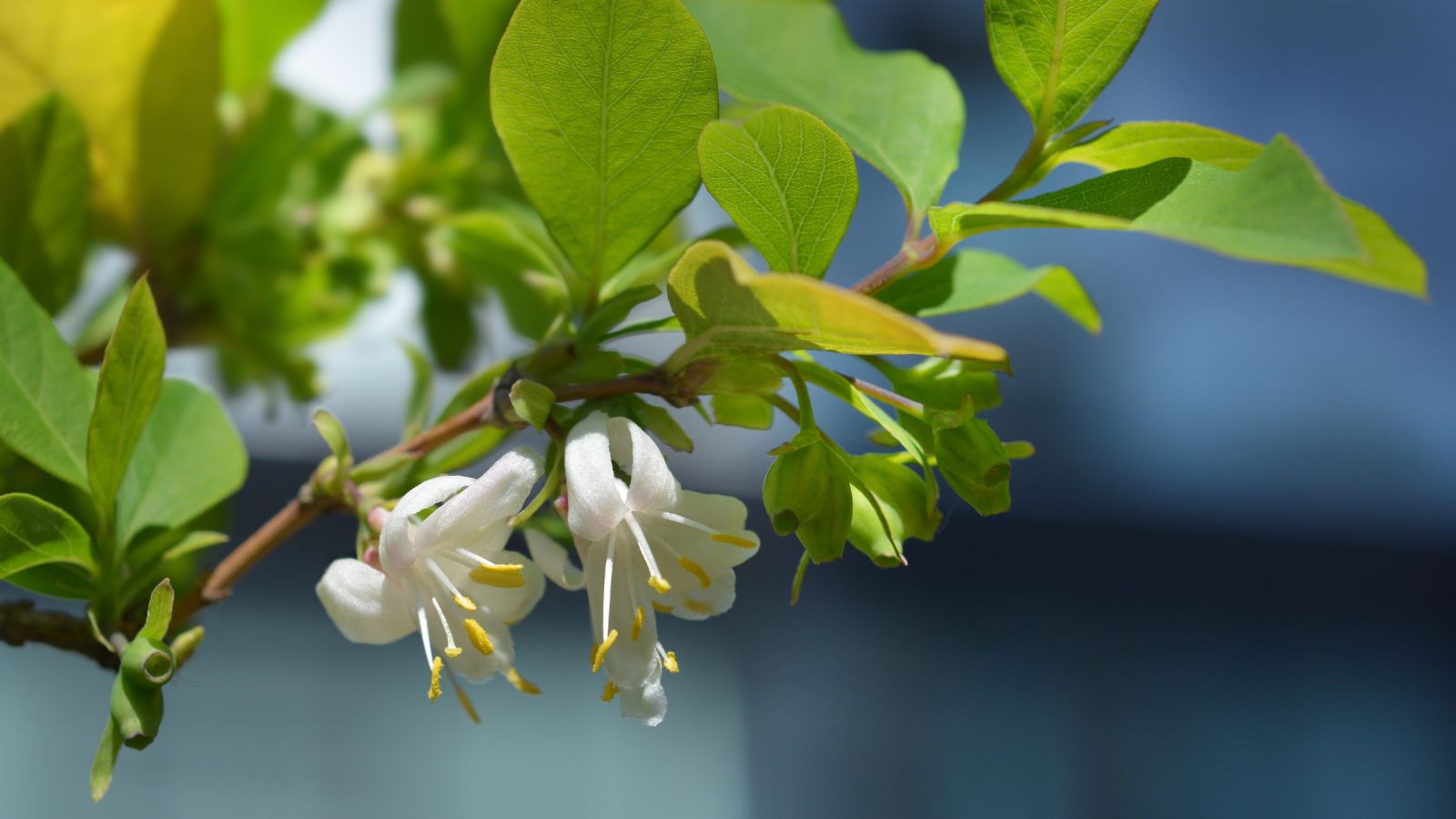
This deciduous shrub grows wild in forests throughout eastern, southern, and central China. It forms dense thickets over time as birds and other animals disperse the seeds after they eat the berries. New shoots sprout from existing crowns and widen the shrubs’ bases.
The shrubs sometimes pop up near forest edges where the sun streams in. They take advantage of the ample sunlight to grow up to ten feet tall!
Characteristics

Winter honeysuckle sprouts bright green, oval leaves in pairs along its stems. The leaves can have a purple-blue tinge to them as they fall in autumn or as they emerge in early spring. Before the leaf buds open, dozens of fragrant white flowers erupt from the shrubs. They decorate the naked branches until berries form in their place.
Pollinated flowers take a few weeks to morph into berries. You’ll see small red berries throughout the shrub from spring through summer. They fall to the ground and sprout new seedlings, or birds eat them and disperse the seeds far from the original shrub.
Planting
Whether you’re growing new honeysuckle seedlings from seeds or are purchasing potted plants, moving this shrub into your garden is straightforward. We’ll set it up for success so it’ll need less maintenance later.
Growing from Seed

It’s best to grow this honeysuckle from seeds outdoors rather than indoors, as it requires some cold stratification to germinate. The seeds benefit from two to three months of winter temperatures while they’re in the soil. As days lengthen and warm in spring, the seedlings emerge from their protective shells.
Start by obtaining winter honeysuckle seeds. If purchasing online, search for the plant’s scientific name, Lonicera fragrantissima, to ensure you obtain the right species. You may also collect seeds from existing shrubs nearby by isolating them from the fruit.
Once you find seeds, prepare pots or beds for planting. Use medium-sized pots if you’re growing the seedlings in containers, as their roots need some space to grow. Fill them with a well-draining potting soil mix, plant the seeds a half inch below the surface, and water them well.
If you’re planting in beds, prepare them for planting by removing weeds and debris. Mix compost in on top, then sow seeds a half-inch deep. Keep the site moist but not soggy, and wait for seedlings to pop up in spring.
Transplanting
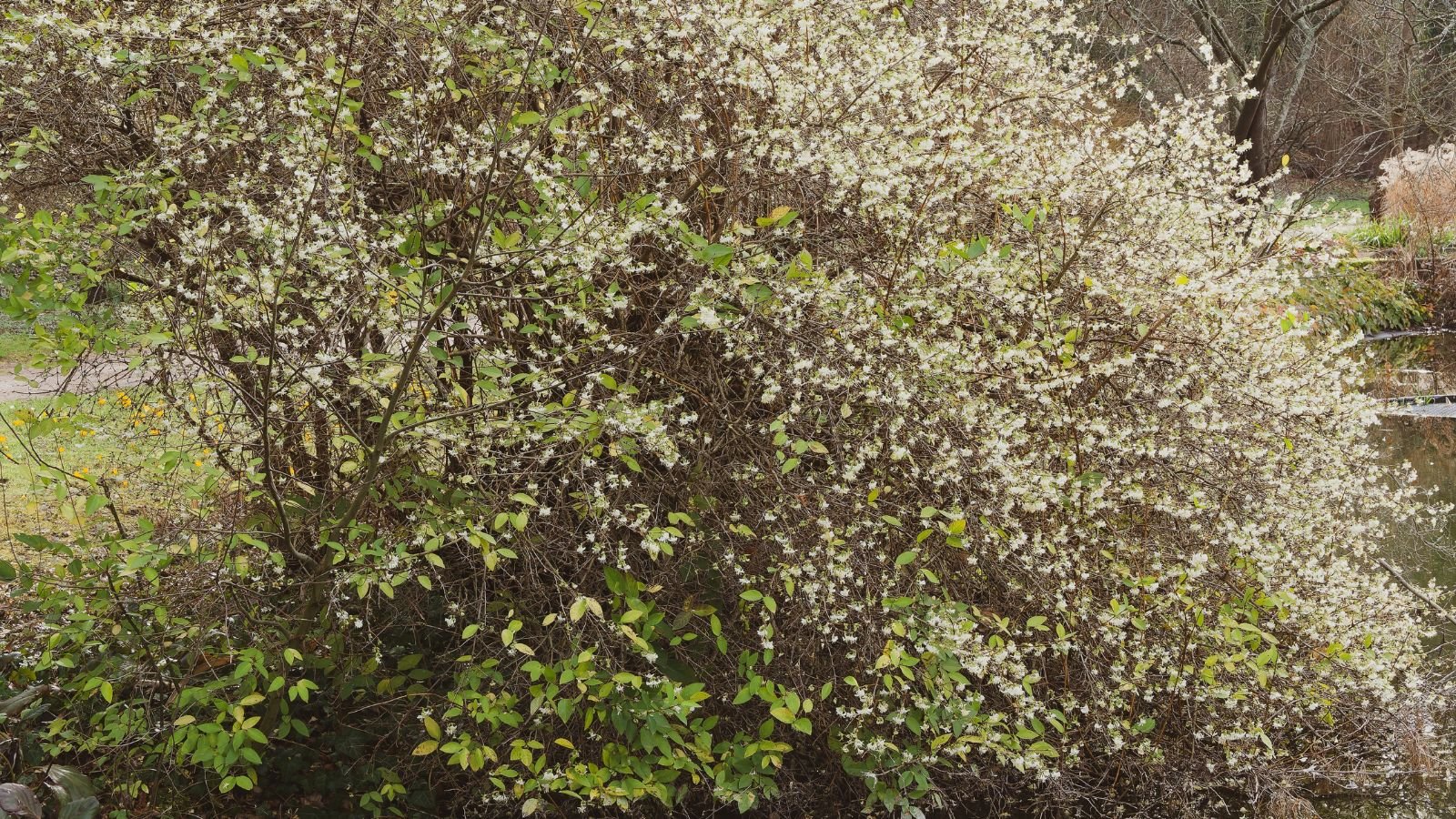
Honeysuckle seedlings are ready for transplanting when their roots start poking out of their pots. They should have plenty of stems with leaves or buds and a strong base. If the seedlings fall over or have shallow roots, give them some more time before you transplant them.
Before transplanting, it’s important to prepare the planting hole; you’ll ensure your shrub has a successful start in your garden. Prepare by digging a hole that’s as deep and twice as wide as the shrub’s rootball. Avoid adding soil amendments at this time, as they encourage root circling in the planting hole. Use your garden’s native soil for the best results.
After digging a hole, find your potted specimen and free it of its container. Remove any bound or circling roots, as well as any that grow up instead of down. Then, set the shrub in its hole and backfill the soil around the roots. Ensure the dirt reaches the soil’s surface, and avoid burying the plant’s crown too deep.
Water the site well, then continue caring for your shrub throughout the seasons. Boost your newly planted honeysuckle’s growth by adding compost or leaf mold to the soil in a three-inch thick layer. It’ll insulate the roots while also adding beneficial nutrients and microorganisms to the soil.
How to Grow
This honeysuckle has few stipulations when it comes to growing in yards and gardens. Part of its widespread popularity stems from how easy it is to grow. Give it what it needs, and it’ll reward you with fragrant blossoms each spring.
Light

Grant your shrub full sun or partial shade, using whatever exposure your garden has to offer. This honeysuckle prefers full sun, although it’ll tolerate partial shade with less water. You’ll know your shrub is starving for light if it has leggy growth and few leaves or flowers.
Long, hot summer heat may be too intense for this shrub to handle in warm regions of zone 8. Grant it afternoon shade to protect it from the hottest hours of the day.
Water

Unlike some other honeysuckles, this species prefers growing on moist to dry sites rather than excessively wet ones. It hates wet feet and will struggle in soggy soil. The best way to water it is to let the soil surface dry before adding more moisture. If the site is wet already, wait a few days to irrigate until it’s dry again.
Potted plants may need more water than in-ground specimens. Test their moisture levels daily during hot summers, and apply water if necessary to ensure they don’t dry out completely.
Soil

The best way to ward off root rot is to use well-draining soil. It’s dirt that allows water to flow freely, ensuring excess moisture drains instead of sitting around. Well-draining soil also has plenty of holes and spaces in it that trap air and help plant roots breathe.
Managing soil in outdoor beds is a bit more challenging than in containers. You can find a free-draining potting soil mix at the store and fill pots with it. Outdoors, you must amend the soil so it slowly evolves into rich, crumbly garden dirt.
Adding compost, leaf mold, or organic mulch to the site is the best way to encourage fertile, free-draining soil. The organic matter decays in place, adding structure, porosity, and fertility to the site. Amend garden beds ahead of planting, and continue amending them as you need to maintain a high soil quality.
Fertilizing

Potted honeysuckles need regular fertilizer during the growing season, while in-ground ones fare well with nutrients from the soil. Regular additions of compost lessen the amount of fertilizer they need.
Use a well-balanced organic fertilizer for best results, as salt-based fertilizers often strip the soil of microbial life. Apply a regular dose every month during the growing season for potted plants and once or twice a year for honeysuckles growing in the ground.
Maintenance

These shrubs are rangy, spindly, and twisted. They sprout stems irregularly; you’ll see them crisscrossing in and out amongst each other. Prune them if you’d like to keep them a certain size. Otherwise, let them grow as wild as they please.
The best time to prune winter honeysuckle is shortly after it flowers. This helps you avoid cutting off next year’s blooms as they form in the fall. When pruning, remove up to a third of the plant at a time, then let it recover for a growing season before pruning again.
These shrubs spread rapidly once they establish themselves. You may have to remove seedlings as they appear to prevent thickets from forming. Remove them when they’re young, so you don’t have to wrestle them out of the ground.
Propagation
This deciduous shrub is incredibly easy to propagate. Divide existing specimens, take cuttings from them, or save their seeds to grow more honeysuckle plants.
Cuttings

You can grow honeysuckle from hardwood or softwood cuttings. Take hardwood cuttings in late fall or winter, and softwood ones in midsummer. Softwood cuttings are more reliable, as they have time to form roots before the winter season.
For softwood cuttings, choose stems that have new, green growth on them. Cut off four to six-inch pieces of the stems and remove their lower leaves. Leave a few on top so the cut stems can continue photosynthesizing, then place these in small pots with potting soil.
Keep the cuttings moist, not soggy, and give them lots of humidity. Add a see-through dome on top of them to trap humidity in dry regions, removing it once a day for airflow. Place them under dappled shade, and they’ll form roots in a few days or weeks.
Hardwood cuttings are a bit different. You’ll remove stem pieces that have next year’s buds on them in winter. Plant them outdoors in loose soil, and keep them moist but not soggy. They’ll form roots and shoots in spring as temperatures warm.
For both types of cuttings, wait until they have sufficient roots poking out of their drainage holes before transplanting them. Hardwood ones may need a year of growing in their containers before they’re ready to move.
Division

Division is a little more challenging than taking cuttings. You’ll have to dig up your dormant shrub, split it into two or three, and rebury each piece. Do this during the dormant season in fall or early spring to avoid shocking your plant.
Start by digging up your shrub, making sure to leave the root ball intact. Dig one to two feet from the shrub’s crown to avoid damaging the roots. Lift the honeysuckle out of its hole, then take a second to inspect it. Look for parts with healthy roots and stems that can separate easily from the parent plant.
Divide your honeysuckle using a saw, knife, or long pruners. You want to make a clean slice through woody stems to avoid creating large, jagged wounds. Slice mature specimens into two or three pieces, then transplant each into its new home. The shrubs handle division every three to five years—the break allows them to recuperate.
Seed Saving
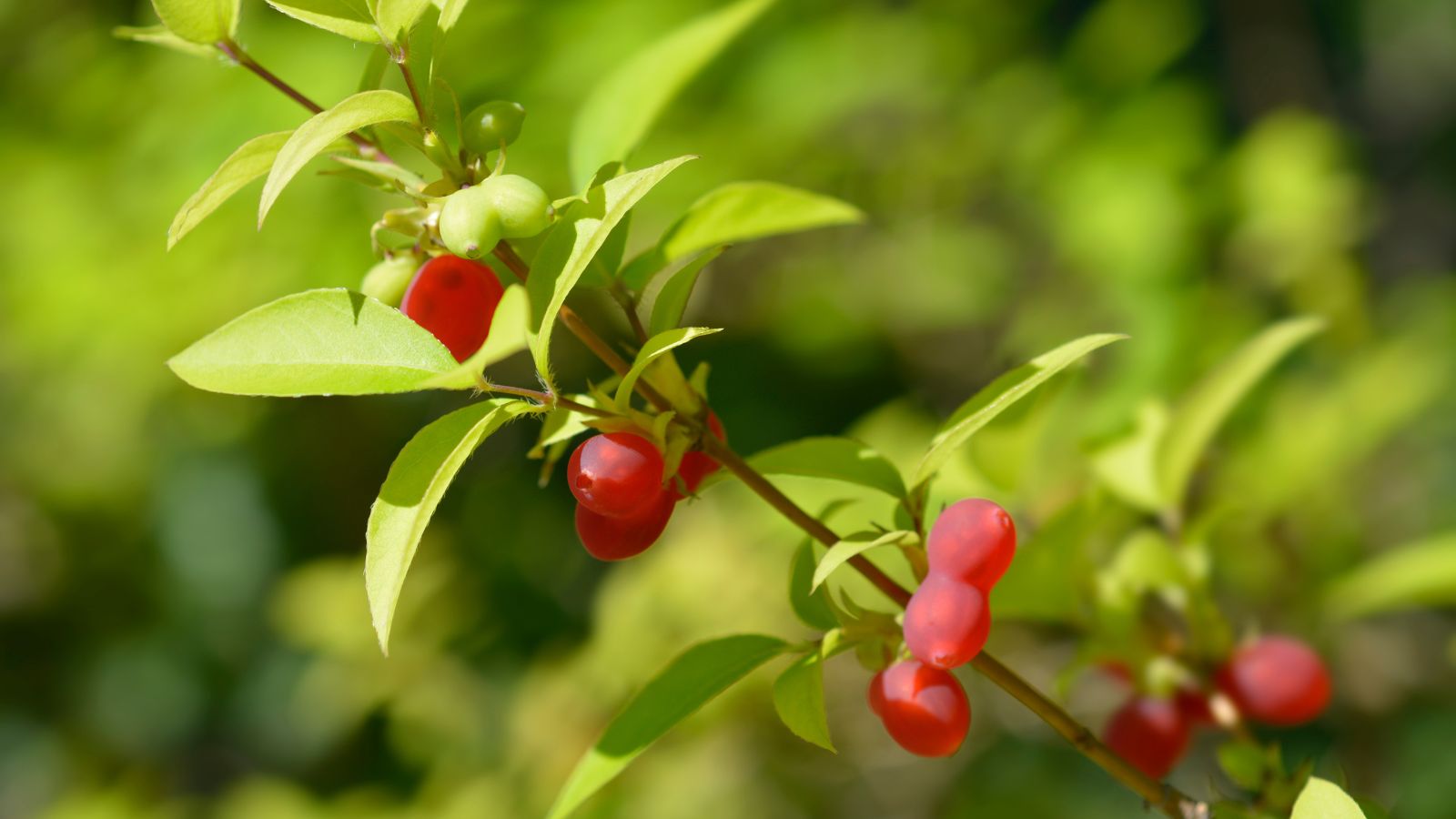
Winter honeysuckles drop small fruits filled with seeds inside. Collect them when they’re ripe, and you’ll have a backup seed supply! Wait for the fruits to ripen first—they’ll turn deep red and plump before falling off the shrub. Collect them off the shrub or wait to pick them up off the ground.
Now, we’ll process the fruits to isolate the seeds. Start by opening each fruit and removing the seeds from the pulp. Rinse the seeds off with a mesh strainer or a similar tool, then set them aside to dry. Once they’re dry, they’re ready for long-term storage.
Store dry seeds in plastic, glass, or paper containers. Stow them away in a cool, dark location until you’re ready to sow them. They’ll stay ready for a year or longer under ideal conditions.
Native Plant Substitutes
Because winter and other non-native bush honeysuckles tend to be weedy and aggressive in North America, you might consider planting a native plant substitute. These four alternatives perform well in different regions of the country, giving every gardener an option!
Twinberry Honeysuckle

Twinberry honeysuckle, Lonicera involucrata, is an understory deciduous shrub native to large swaths of the West. It performs well from hardiness zones 4 through 10, outperforming winter honeysuckle in warm zones 9 and 10. Give twinberry honeysuckle consistent moisture and partial shade, and it’ll reward you with bright yellow blossoms and black-blue fruits with red collars.
Northern Bush Honeysuckle
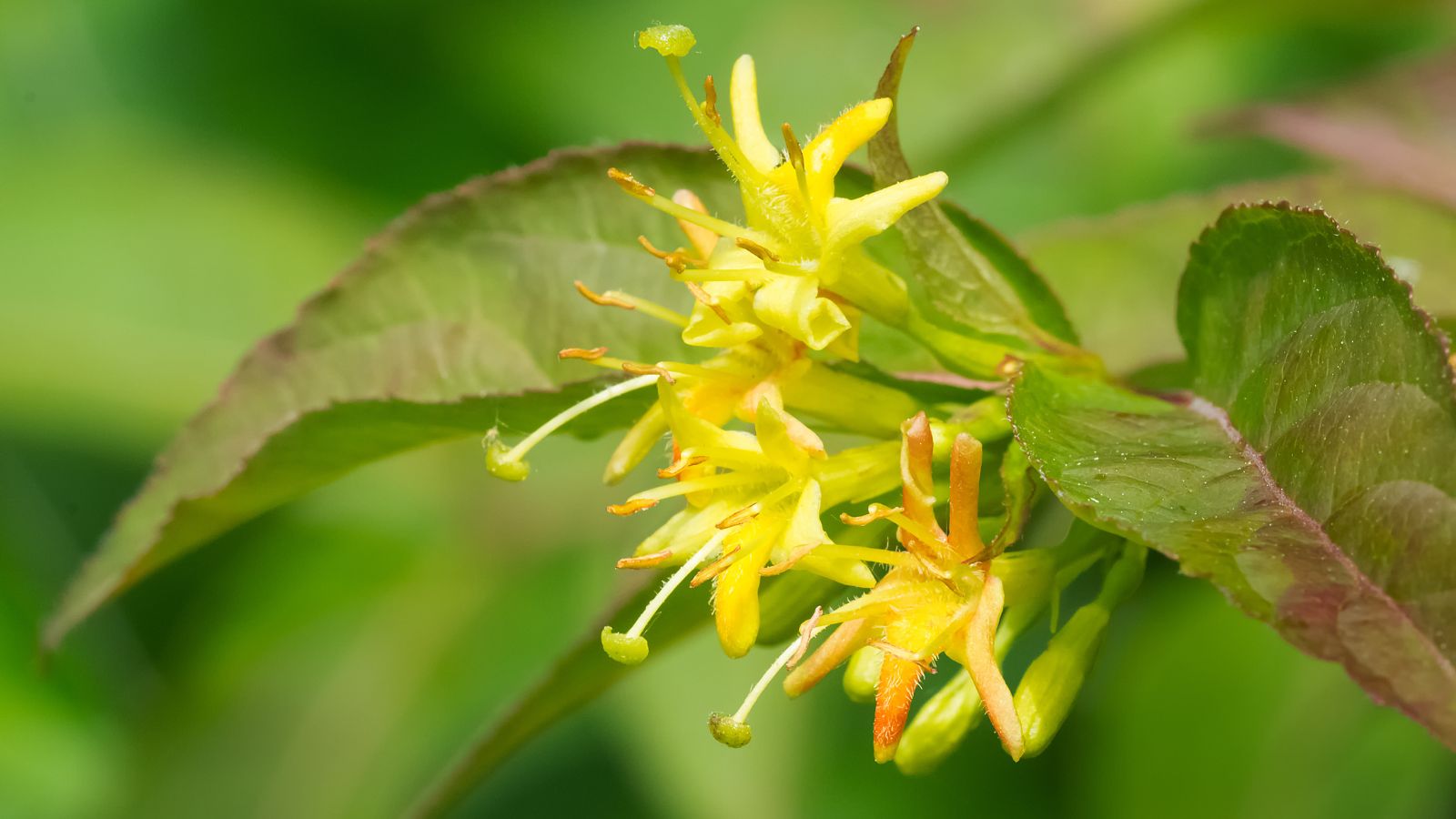
This bushy honeysuckle isn’t a true honeysuckle; its scientific name is Diervilla lonicera and it originates in dry, rocky regions of northeastern states. Grant it full sun and little water during the growing season. It’s more tolerant of cold than other honeysuckles, surviving well from zones 3 through 7.
Limber Honeysuckle

This native honeysuckle is perfect for gardeners in central and eastern regions of the U.S. It needs a stake to form a shrub, as it tends to lean and ramble more than the previous species. Limber honeysuckle erupts into bloom in early spring with fragrant, red blooms. They’ll turn into bright red berries from spring through summer, offering food for birds and ornamental interest for you to enjoy!
Coral Honeysuckle

The last native honeysuckle on this list is a vine and not a shrub. It makes the list because of its beautiful, lush flowers that decorate the stems each spring. Coral honeysuckle, so aptly named, sprouts red blossoms with yellow stigmas and anthers. The vines climb up to 20 feet tall and are perfect for growing underneath taller trees or trellises.
Common Problems
Winter honeysuckles are popular ornamental shrubs because few pests or pathogens attack them. If insects or diseases target your shrubs, try these easy methods to rectify the situation.
Pests

Aphids, scales, sawflies, white flies, loopers, plant hoppers, flea beetles, and webworms may target winter honeysuckles. Yes, this is a long list! Do not fear, though, as most of these pests rarely harm the shrubs. Because of their deciduous nature, they shed their leaves each fall and receive a fresh start in spring. You can remove debris at the end of the season to prevent pest proliferation.
If pests persist from season to season, consider trying to remove them. Spray them daily with strong streams of water for a week or two until they disappear. Pesticides interfere with the natural food web, killing insect predators and harming larger animals. Only use organic options like neem or horticultural oil for extreme infestations, and spray in the evening or at dawn to prevent harm to pollinators.
Diseases

Blight, leaf spots, and powdery mildew may infect tender honeysuckle leaves. Prevent all three by encouraging consistent airflow around the shrub. Prune extraneous branches that touch the ground or crowd other stems, and give each shrub sufficient space from other plants.
Blight, unfortunately, kills plants and is hard to remedy. After removing your dead shrub, plant a new one in a site far from the original. Wait a few years before planting honeysuckles in the area to let the blight starve and die out.
Frequently Asked Questions
When is best to prune a winter honeysuckle bush?
Late spring is the opportune time to prune this shrub. Wait until after the flowers fade and fall off, then prune no more than a third of the shrub.
Is winter honeysuckle a climber?
No, this type climbs less than other vining species like coral or Japanese honeysuckle. It’s a clambering shrub with branches that arch up and over.
Does winter honeysuckle sprout edible berries?
No, this is not an edible honeysuckle. Choose sweetberry honeysuckle, Lonicera caerulea, if you’d like a vine that grows edible fruits.




